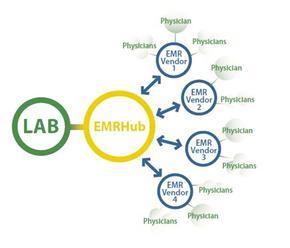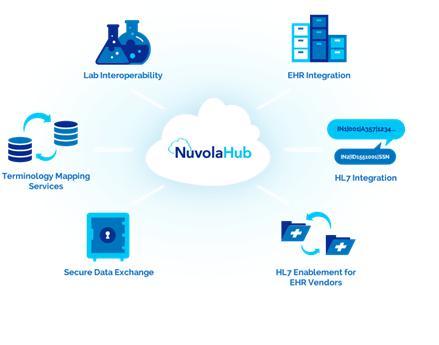Vendor-neutral hubs have achieved a certain level of interoperability between multiple healthcare entities with simplicity and reduced cost.
It’s a quagmire alright. And all those involved in the interoperability bog are scrambling to come up with new and shiny solutions that will enable the effective interfaces that will make and keep regulators, providers, consumers—and each other—happy.
Though it’s not necessarily new and shiny, this one has achieved a certain level of interoperability between multiple healthcare entities with simplicity and reduced cost.
What are vendor-neutral hubs?
Vendor-neutral hubs involve a connectivity model that the laboratory industry has been using for a number of years, since major providers of laboratory services face a challenge that mirrors what patients and providers encounter—the need to interact with many systems in many locations.
They’ve met this challenge not by investing enormous resources to meet the ever-changing software needs of each individual provider, but by interacting with “vendor-neutral hubs” that provide a single interface with the laboratory information system (LIS), enabling EMR integration with multiple vendors that are deployed in multiple healthcare settings.
In an Advance Healthcare Network for Laboratory article, “EMR Integration for Outreach Success”, Emily Ruffing outlines the challenges that laboratory providers face, which sound hauntingly familiar to the growing scenario in healthcare for both patients and providers:
“The difficulty labs face is that each EHR and laboratory information system (LIS) has its own interface requirements. Adding to this is the reality that providers, who typically use multiple labs on a regular basis, are unable to support the connectivity needed on their end, as they don’t maintain dedicated IT staff. In addition, it is difficult for these providers to afford the connectivity fees that EMR vendors are setting…An obvious solution is for labs to make one connection from their LIS to a connectivity hub which can distribute data to an unlimited number of EMRs and support provider direct order entry.”
Ruffing notes the benefits of such a vendor-neutral connectivity hub:
- Increases efficiency and cost-effectiveness to optimize EMR usefulness
- Supports the ability to meet MU requirements
- Provides the ability to interface with multiple and disparate EMR systems
- Doesn’t require extensive IT resources
- Eliminates costs of building, implementing and maintaining complex point-to-point interfaces
- Ability to focus on laboratory expertise instead of IT expertise needs
Through a “hub and spike” structure for virtual integration platform architecture, only a single interface is required to a lab’s LIS, which enables it to connect with every EMR of the providers they serve.
“A dedicated connectivity vendor facilitates lab order processing and reduces EMR implementation time and cost and provides a reliable connection between its LIS and the vast array of EMRs they have to accommodate. The vendor also provides consistent and top-notch support and maintenance, freeing lab IT personnel to focus on core functions and other IT challenges…”
Examples of vendor-neutral hubs
One such connectivity vendor is Lifepoint EMRHub, which requires only one connection to exchange information with an unlimited number of EMRs. Feliks Pinkhusovich, the CEO of Lenco Diagnostic Laboratories, Inc., described their success with Lifepoint:
“Lifepoint’s EMRHub eliminated building and maintaining custom point-to-point interfaces that we previously relied on. Out IT staff is now more focused on building our outreach business. We benefit from Lifepoint’s vendor neutral approach that allows us to process clinical message and lab orders with our existing LIS and provider EMRs. The combination of Software as a Service (SaaS) delivery and rapid implementation has delivered substantial cost savings.”

LifePoint’s EMR Hub Solution
Copyright © 2014 Labtest.com, Inc. Reprinted with permission.
http://www.lifepoint.com/solutions/emrhub/
Tom Asher, VP of sales at Lenco put it this way:
“We recognize that as more of our providers adopt and implement EMRs, their demands on our IT capabilities will increase. We are seeing stand-alone portals and point-to-point interfaces being replaced with bi-directional and fully integrated electronic connectivity options which we can now offer.”
Another connectivity provider of vendor neutral hubs is Iron Bridge Integration (IBI), which recently announced its launch of Pub Hub, “the Healthcare Industry’s First Public Health Clearinghouse.”
Driven by the Population and Public Health requirement in Meaningful Use Stage 2, Pub Hub was developed to solve the
“public health data transmission problem by having prebuilt connections to all states with active electronic registries.” Pub Hub is built on IBI’s Nuvola Hub model, which is touted as the world’s first HiPaaS (Health Integration Platform as a Service), enabling its customers to “build end-to-end integrations with healthcare payers, providers, and EHR vendors through the cloud at a fraction of the cost.”
Iron Bridge says it’s unique because of Nuvola Hub’s 3 key differentiators:
- A commercialized approach to interoperability – a reusable connector-based approach allows for faster software delivery and implementation
- Healthcare’s first Integration Platform as a Service (HiPaaS) – unmatched scalability through smart automation software delivery processes that solve integration problems swiftly and efficiently
- Alignment with the latest integration technology – renders irrelevant antiquated technologies and eliminates inefficient manual steps; remains current with regard to integration requirements
“Iron Bridge Integration, Inc was founded on the ideas that every healthcare provider, large or small, should be able to harness the power of the cloud to inexpensively and easily exchange health data. Gone are the days of buying expensive integration hardware and software to solve simple healthcare integration needs. The Nuvola Hub Healthcare Integration Platform as a Service (HiPaas) allows both healthcare provider and technology vendors to build and offer repeatable integrated healthcare applications in days, not months. The Nuvola Hub makes simple healthcare integration easy, and makes complex healthcare integration possible.”
In addition to the Nuvola Hub and Pub Hub offerings, IBI offers complete healthcare integration IT consulting services for several integration/EHR vendors, including Cerner Millennium®, MirthConnect™, and InfoCloverLeaf® Integration Suite.

Nuvola Hub Healthcare Integration Platform as a Service (HiPaaS)
Copyright © 2014 Iron Bridge Integration. Reprinted with permission.
http://ironbridgeintegration.com/solutions/nuvola-hub/
Lifepoint and IBI both offer a variety of solutions, and continue to build upon their offerings—serving as excellent examples of what the future of interoperability may look like.
Connectivity providers may be some of the best positioned on the Health IT landscape to provide solutions to the interoperability challenges that continue to stump EMR vendors and healthcare providers—and they may experience significant business benefits by doing so.
Log in or register for FREE for full access to ALL site features
As a member of the nuviun community, you can benefit from:
- 24/7 unlimited access to the content library
- Full access to the company and people directories
- Unlimited discussion and commenting privileges
- Your own searchable professional profile






.jpg)
